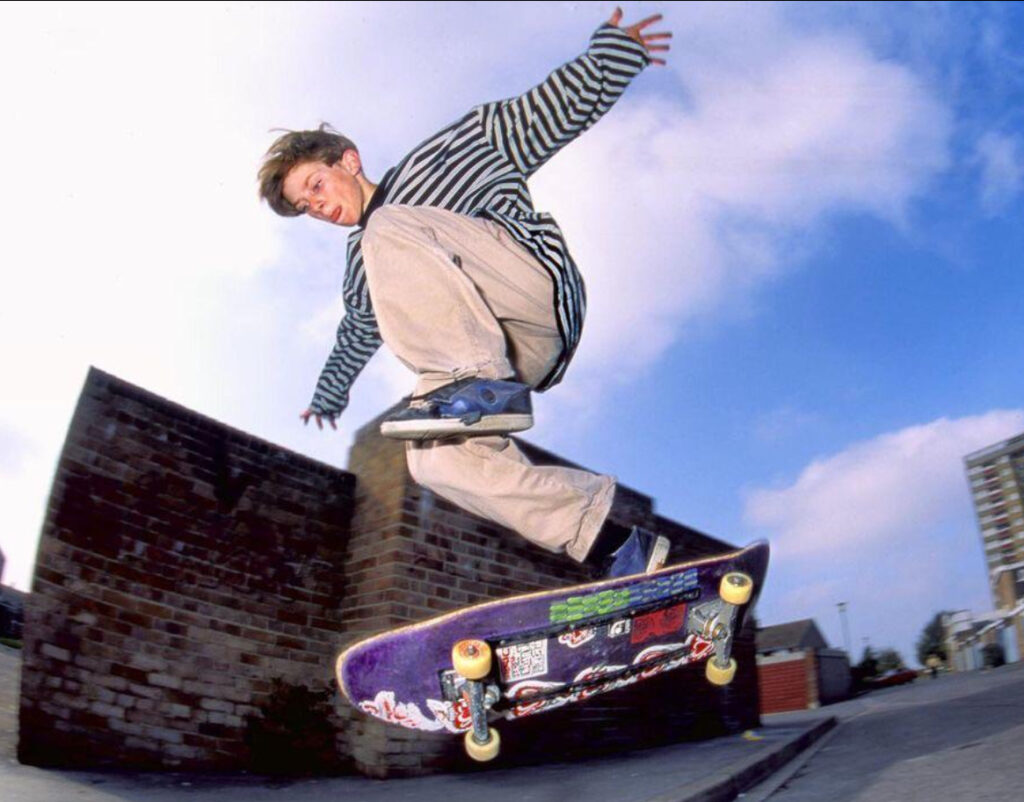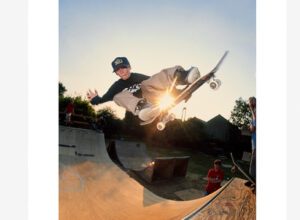
Tom Penny is one of the most legendary figures in skateboarding history. His effortless style, technical precision, and laid-back approach to skating set him apart from his peers and cemented his place as a true icon of the sport. While his impact on skateboarding spans decades, 1991 was a particularly significant year—a time when a young Tom Penny was beginning to make waves in the UK skate scene before ultimately becoming a global phenomenon.
Tom Penny’s Early Years: A Skater from Oxford
Tom Penny was born on April 13, 1977, in Dorchester, England, and was raised in Oxford, a city not traditionally known for its skateboarding scene. Unlike major skate hubs like London, Los Angeles, or San Francisco, Oxford had a smaller but dedicated skate community. Penny found inspiration in what was available, developing his skills in local spots like Botley Bowl and taking cues from skate magazines, videos, and the older skaters around him.
By the late 1980s, Penny was already showcasing a natural ability that was far beyond his years. His flawless execution, nonchalant demeanor, and ability to make difficult tricks look easy caught the attention of local skaters and photographers. His smooth, floaty style made even the most complex tricks appear as if they were second nature.
1991: The Year of Emergence
The Botley Jam and R.A.D. Magazine Recognition
One of the key moments in Penny’s early career came in July 1991, when he participated in the Botley Jam, a local skateboarding contest in Oxford. Competing in the under-15s category, Penny demonstrated remarkable control and creativity, setting himself apart from the other young skaters. His performance at this event earned him recognition in R.A.D. (Read And Destroy) Magazine, one of the UK’s most influential skateboarding publications at the time.
R.A.D. Magazine’s coverage of Penny in 1991 was pivotal. Tim Leighton-Boyce, a prominent skate photographer, captured images of Penny skating with an effortless style that was years ahead of his competition. These early photos were some of the first glimpses the broader skateboarding world got of Penny’s abilities.
Style and Influence at an Early Age
What made Penny stand out in 1991 wasn’t just his ability to land tricks—it was how he landed them. Even at a young age, his skating already possessed the grace and flow that would later define his career. He never seemed to force anything—every flip trick, grind, and transition was done with such ease that it almost looked like he was skating in slow motion.
His early footage from this period, though rare, shows glimpses of his soon-to-be-iconic style:
•Crisp flicks on flip tricks
•Unique board control on ledges and ramps
•Relaxed landings that looked completely effortless
•A nonchalant attitude that set him apart from more aggressive skaters
Unlike many skaters of the early ‘90s who relied on big setups and aggressive hammers, Penny’s approach was more graceful and technical. His skating reflected the emerging street style of the early 1990s, characterized by clean execution and mastery of ledges, rails, and stair sets.
1991 and the UK Skate Scene
During the early 1990s, skateboarding was undergoing a major transformation. The vert skating boom of the ‘80s was fading, and street skating was becoming the dominant force in the sport. UK skateboarding was still developing compared to the more established scenes in the US, but it had its own legends and underground heroes.
In 1991, Penny was skating alongside UK pros and emerging talents, but it was clear that he had something different. His blend of technical skill, natural flow, and an almost mystical presence on his board made him stand out.
R.A.D. Magazine and the Rise of UK Skateboarding
Publications like R.A.D. Magazine played a huge role in documenting and shaping the UK skate scene. Tom Penny’s early photos in 1991 issues of R.A.D. helped introduce his name to the larger skateboarding community. These images weren’t just snapshots of a talented kid—they were a glimpse into the future of skateboarding.
Some of the most iconic early photos of Penny in 1991 include:
•Skating at Botley Bowl
•Nailing tech tricks with perfect control
•Demonstrating his laid-back, effortless execution
While Penny wasn’t yet a global name, the seeds were being planted. His style was being noticed, and he was steadily building a reputation as a once-in-a-generation talent.
The Breakthrough Years: 1992–1995
After 1991, Penny’s career rapidly accelerated. He began skating for Death Box Skateboards, a UK-based brand that would later evolve into Flip Skateboards, the company with which Penny would become synonymous.
His Move to Flip and International Recognition
In the mid-1990s, Penny transitioned to Flip Skateboards, which would become his long-term sponsor. His 1994 and 1995 video parts in early Flip productions, as well as his game-changing part in “Welcome to Hell” (1996), solidified him as one of the greatest skaters of all time.
Some of his signature moments post-1991 include:
•His effortless frontside flips that seemed to defy gravity
•Iconic sessions at Huntington Beach, California
•His battle at Arto Saari’s famous rail in Flip videos
•Competing in contests but often skating just for fun
By the mid to late 1990s, Penny’s influence had spread worldwide. His relaxed demeanor, smooth execution, and complete control over his board set the standard for style in street skating.
The Legacy of Tom Penny
A Skater’s Skater
Even though Penny never chased competitions or endorsements like some of his peers, he remained a legend in skate culture. His approach to skateboarding wasn’t about winning titles—it was about the pure love of skating.
Some key aspects of Penny’s legacy include:
•His effortless execution: No one made skateboarding look as smooth as Penny.
•His laid-back, mystical presence: Penny often skated with an almost trance-like state, completely in sync with his board.
•His influence on generations: Skaters from Eric Koston to Paul Rodriguez and beyond cite Penny as a major influence.
•His staying power: Even decades after 1991, Penny remains one of the most respected figures in skateboarding.
Why 1991 Mattered
While Penny’s peak influence came in the late ‘90s, 1991 was the year that started it all. It was the year he first got noticed, first appeared in skate magazines, and first showed the world that he was something special.
His Botley Jam appearance, early R.A.D. Magazine features, and local reputation in Oxford laid the foundation for everything that followed.
Final Thoughts: Tom Penny, the Timeless Icon
Skateboarding has had many game-changers, icons, and legends, but few have influenced style and flow the way Tom Penny has. His journey began in 1991, in a small but growing UK skate scene, and within just a few years, he would change the global skateboarding landscape forever.
Even today, Penny’s legacy remains untouchable. His early clips, from 1991 and beyond, still inspire new generations of skaters who strive to replicate the smoothness, control, and effortless perfection that made him a legend.
1991 wasn’t just another year—it was the beginning of something legendary.
No comments yet.









